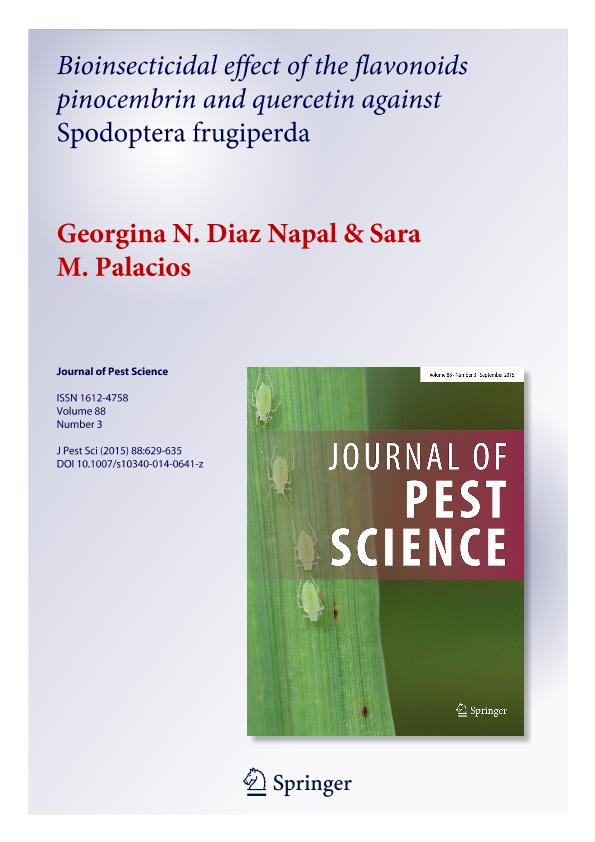Mostrar el registro sencillo del ítem
dc.contributor.author
Diaz Napal, Georgina Natalia

dc.contributor.author
Palacios, Sara Maria

dc.date.available
2018-03-05T19:13:10Z
dc.date.issued
2015-09
dc.identifier.citation
Diaz Napal, Georgina Natalia; Palacios, Sara Maria; Bioinsecticidal effect of the flavonoids pinocembrin and quercetin against Spodoptera frugiperda; Springer Heidelberg; Journal of Pest Science; 88; 3; 9-2015; 629-635
dc.identifier.issn
1612-4758
dc.identifier.uri
http://hdl.handle.net/11336/37842
dc.description.abstract
Flavonoids function in many aspects of plant–insect interactions, but the responses of insects to these compounds vary greatly. In this study, we determined the effects of two widely distributed flavonoids, pinocembrin and quercetin, on the feeding behavior, survival, and development of the fall armyworm Spodoptera frugiperda J.E. (Smith) (Lepidoptera: Noctuidae). In a choice test, S. frugiperda larvae strongly rejected leaves treated with pinocembrin at concentrations of 10, 50, or 100 μg/cm2. Larvae fed normally on leaves treated with quercetin at 10 and 50 μg/cm2, but showed 57 % deterrence when fed on leaves treated with 100 μg/cm2 quercetin. At concentrations of 0.01–1 µg/cm2, pinocembrin and quercetin functioned as phagostimulants for S. frugiperda. In a multiple-choice experiment, S. frugiperda larvae preferred to consume untreated leaves or those treated with 0.1 µg/cm2 pinocembrin, but rejected leaves treated with 5–50 µg/cm2 pinocembrin. In a no-choice feeding experiment, larvae fed on leaves treated with 5 and 50 μg/cm2 pinocembrin consumed less than those fed on leaves treated with 0.1 and 1 μg/cm2 pinocembrin or untreated leaves. Pinocembrin at 1–50 μg/cm2 negatively affected larval weight and survival, thus showing a toxic effect. In contrast, leaf consumption and larval weight were not significantly affected by quercetin at 0.1, 1, 5, and 50 μg/cm2, and mortality rates only slightly increased. Because of its dual activity, pinocembrin could be used for insect control in a stimulo-deterrent diversionary strategy: the same compound could promote both stimulate (low doses) and deter insect activity (high doses).
dc.format
application/pdf
dc.language.iso
eng
dc.publisher
Springer Heidelberg

dc.rights
info:eu-repo/semantics/openAccess
dc.rights.uri
https://creativecommons.org/licenses/by-nc-sa/2.5/ar/
dc.subject
Antifeedant
dc.subject
Flavonoids
dc.subject
Lepidoptera
dc.subject
Noctuidae
dc.subject
Pinocembrin
dc.subject
Quercetin
dc.subject.classification
Otras Ciencias Biológicas

dc.subject.classification
Ciencias Biológicas

dc.subject.classification
CIENCIAS NATURALES Y EXACTAS

dc.title
Bioinsecticidal effect of the flavonoids pinocembrin and quercetin against Spodoptera frugiperda
dc.type
info:eu-repo/semantics/article
dc.type
info:ar-repo/semantics/artículo
dc.type
info:eu-repo/semantics/publishedVersion
dc.date.updated
2018-03-02T13:59:47Z
dc.identifier.eissn
1612-4766
dc.journal.volume
88
dc.journal.number
3
dc.journal.pagination
629-635
dc.journal.pais
Alemania

dc.description.fil
Fil: Diaz Napal, Georgina Natalia. Universidad Catolica de Córdoba. Facultad de Ciencias Químicas; Argentina. Consejo Nacional de Investigaciones Científicas y Técnicas; Argentina
dc.description.fil
Fil: Palacios, Sara Maria. Universidad Catolica de Córdoba. Facultad de Ciencias Químicas; Argentina. Consejo Nacional de Investigaciones Científicas y Técnicas; Argentina
dc.journal.title
Journal of Pest Science

dc.relation.alternativeid
info:eu-repo/semantics/altIdentifier/doi/http://dx.doi.org/10.1007/s10340-014-0641-z
dc.relation.alternativeid
info:eu-repo/semantics/altIdentifier/url/https://link.springer.com/article/10.1007%2Fs10340-014-0641-z
Archivos asociados
